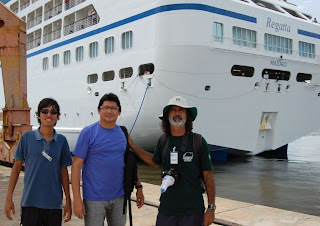 |
| Click here to access homepage |
Tuesday, 29 March 2011
M/V Regatta great times
 |
| Hoatzin |
 |
| Elasticity |
 |
| collecting Brazil nut shells |
 |
| Making manioc flour |
 |
| schooling the kids |
 |
| Horse and chart |
 |
| Flooded forest exploration |
 |
| Notes |
Labels:
cruiseship tour
Sunday, 27 March 2011
Tuesday, 22 March 2011
Great tour awesome buddies
 |
| www.gilserique.com |
 |
| Marco sitting on a gigantic liana |
 |
| Enjoying the Tapajos national Forest from LBA tower |
 |
| posing by a gigantic kapok tree |
 |
| she got lunch |
 |
| Ant, his wife and Marco |
Labels:
Quite special tours
Friday, 18 March 2011
Google translation on ancient Amazon people
While the Old World lived in the darkness of the Middle Ages, civilization experienced a flowering in Brazil cultural.Contemporâneos the Incas and the Mayans were perpetrators of a sophisticated art. Only now beginning to decipher the archeology who were these ancient inhabitants of the earth brasilis.
If we could go back in time and visit the Amazon in a thousand years ago, we would see a different world. There would be cleared and the large area occupied by pastures and crops in the south and southeastern region, the current Para In areas now covered by dense jungles, would stand out clear signs of human occupation: large villages or towns, surrounded by areas plantations and secondary forests, linked together by long and wide paths. In some places, ceremonial centers designed by rows of stone were arranged in circles. Distant points as the island of Marajo is of Acre, for example, artificial embankments were living spaces and rituals. And that is the Bolivian Amazon, we could contemplate a maze of levees, dams and canals spread over thousands of square kilometers.
http://viajeaqui.abril.com.br/national-geographic/edicao-122/antigas-civilizacoes-amazonia-552374.shtml?page=0
Thursday, 17 March 2011
Boca da Valeria
Covering the short distance from the Royal Princess to shore amid water-arching, pink dolphins, my tender penetrated thick, swampy, molasses with its dual-pontoon underside, circumventing two river boats before approaching the wooden, stilt-supported houses and thatch huts marking the Boca da Valeria “pocket of humanity,” which could equally have been considered a “pocket of (arrested) time.” To the river dwellers, this had been “home.” It had been all that they had known. We had brought our preconceived “ideas” of home, which had been all we had known. Neither had been the same, or even remotely close. Perhaps I would find some elements of commonality between the two during my visit.
Read more: http://www.articlesbase.com/exotic-locations-articles/boca-da-valeria-primitive-pocket-of-the-amazon-amazon-river-forest-royal-princess-1750117.html#ixzz1GsCNJEmq
Under Creative Commons License: Attribution
Thursday, 10 March 2011
Seven Seas Mariner....Who is next?
 |
| Seven Seas Mariner is a cruise ship for Regent Seven Seas Cruises (formerly Radisson Seven Seas Cruises). She was the first all-suite, all-balcony ship in the world, and was awarded "Ship of the Year" in 2002 by Ocean and Cruise News |
Labels:
cruiseship,
cruiseship tour
Golden Backed Uakari
 |
| by James Hutchinson |
The black uakari weighs a little less than 3 kg (6.6 lb) and has a head and body length less than 0.5 m (1.6'). There are two subspecies of black uakari. The golden-backed subspecies (Cacajao melanocephalus ouakari) is richly colored with a saddle and back of golden-yellow that contrasts with its darker chestnut-red sides and underparts. Its arms are dark-brown or blackish as are the lower parts of its legs from the knee
 |
| "My" Uakari photographed at Jau river |
The black uakari seems to prefer habitat along small to medium-sized black water streams and lakes, including black water seasonally flooded forests (igapo) and the inland unflooded ("terra firme") forests adjoining such igapo. The majority of its diet is made up of immature seeds. It also eats fruit pulp, leaves and arthropods. The black uakari is arboreal and diurnal. It forages at all levels from the surface of the water in a flooded forest up to the canopy and also descends to the ground to consume seedlings. Groups consist of multiple adult males and females, juveniles, and infants. Large groups of more than 100 black uakaris, some perhaps approaching 200 animals, have been seen. But these large groups result from the temporary fusion of several smaller groups. More long-lasting groups consist of 20 - 70 animals. Black uakaris are very social. Members of a group groom each other frequently. Males are very tolerant of infants, which they carefully guard from danger.
 |
| Charles, Michael, Mike and Raimundo seaching for Uakaris on the Jau River |
 |
| More fruit eaten by the monkeys |
http://www.animalinfo.org/species/primate/cacamela.htm
Labels:
wildlife
Subscribe to:
Posts (Atom)























